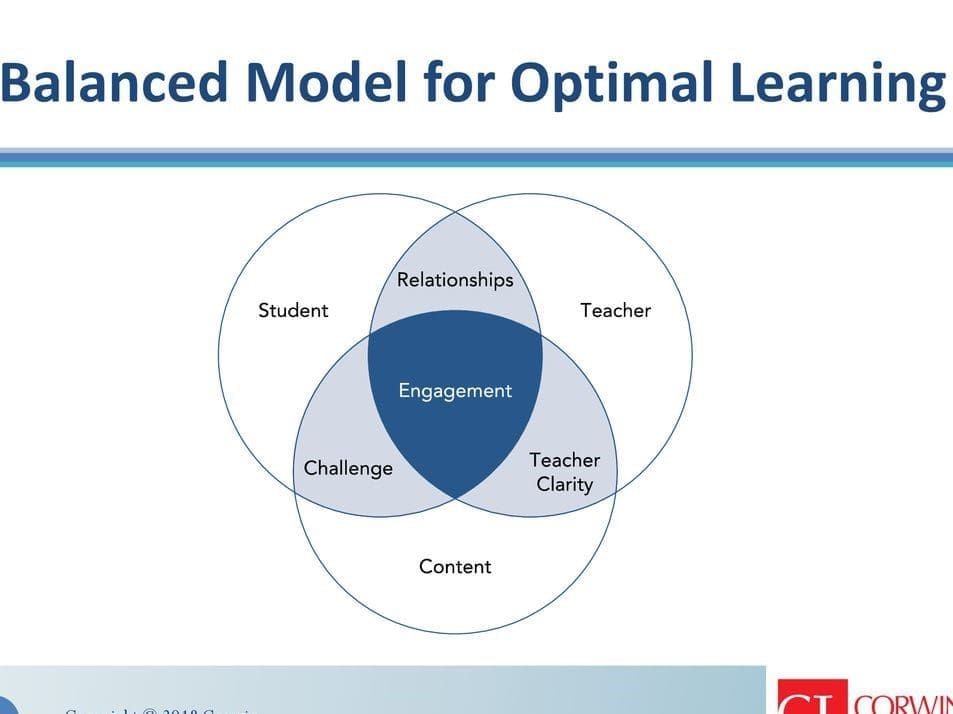Introduction
Strengthen student engagement, author Dr. Richard D Jones, is based on Engagement-Based Learning and Teaching. It is an approach that provides the foundation for developing and strengthening student engagement and the learning process.
Dr. Jones built the foundation through specific principles, habits, skills and strategies. There are three domains of student engagement: Cognitive domain – beliefs and values, Emotional domain – motivation and feelings, and Behavior domain – habits and skills. Teachers and parents work together across all three domains to cultivate and support student engagement at the highest level.
There are six objectives or steps in Engagement Based Learning and Teaching:
1. Cultivate one-on-one relationships. The one-on-one relationship between student and teacher is the critical element that can lead to increased student motivation and higher levels of engagement in academics and school life.
2. Learn new skills and habits. Teachers can learn new skills and habits that help them develop, polish, and enhance their already natural inclination to motivate and engage students.
3. Incorporate systematic strategies. Teachers can learn systematic strategies that facilitate student engagement. Students can develop behavioral skills and habits that lead to increased academic achievement and greater involvement in school life.
4. Take responsibility for student engagement practices. It is primarily the teacher’s responsibility to engage the students, rather than the teacher expecting students to come to class naturally and automatically engaged.
5. Promote a school-wide culture of engagement. The best way to promote high levels of student engagement is to develop and maintain a school-wide initiative dedicated to creating a culture of student engagement, involving students in school activities, and providing a rigorous and relevant education program for all students.
6. Professional development is an important part of increasing student engagement. Staff development, combined with staff ownership and recognition, is critical to developing and maintaining a culture of effective student engagement.
I find Dr. Richard D Jones 6 objectives in Engagement Based Learning and Teaching are a good foundation for strengthening student engagement. I like to go further with Douglas Fisher, Nancy Frey, and Russel J Quaglia, authors of Engagement By Design, where they discuss The Engagement Equation by bringing the pieces together and moving toward the ideal engagement by design for students and teachers.
____________________________________
The Engagement Equation
The authors of Engagement By Design represent Dr. Jones’ three domains of student engagement below:

Authors define “engagement by design” as teachers must intentionally tend to the behavioral, cognitive, and emotional engagement of students in the learning experience. This is the same expectation Dr. Jones has in his Engagement of Learning and Teaching.
Douglas Fisher, Nancy Frey, and Russel J Quaglia bringing it all together using the Balanced Model for Optimal Learning, where it highlights the student, the teacher, and the content. Authors emphasize that these factors must operate in harmony, and have a significant impact on academic and personal outcomes.

Authors point out there are four intersections that lead to the heart of this model. It comes to life when the teacher, student, and content are meaningfully connected. Authors explain the intersection between student and teacher, where relationships are formed, and addressed the concept of teacher clarity, which is critical within the intersection of teacher and content. Authors also address the importance of challenge – the intersection between student and content.
Now the authors will focus on the middle intersection: Engagement.
Authors consider the student engagement equation, as the pieces are brought together and move toward the ideal engagement by design for students and teachers.

Douglas Fisher, Nancy Frey, and Russel J Quaglia break down the equation into components. They consider every component of the equation of great importance. The first component, STC, represents the three factors discussed:
- Students (S) enter the classroom to gather, discover, process, understand, integrate, and ultimately learn information.
- Teachers (T) enter the classroom to share, present, guide, instruct, scaffold, and facilitate students in gaining knowledge. They must know content and possess the skills necessary to present information in a format that is understandable and relevant.
- Content (C) represents information to be learned, and how that information is discovered and shared by both the student and the teacher.
Authors show the top variable in the equation, R + TC + CH represent:
- Relationships (R) are healthy between teachers and students, built upon trust and create an environment of safety in which students can focus on learning, and the teacher can learn more about the student and his or her interests.
- Teacher Clarity (TC) is the combination of teachers knowing what they are supposed to teach, informing students about what they are supposed to learn, and reaching agreements with students about success criteria.
- Challenge (CH) is the balance of difficulty and complexity that affords students a range of experiences that foster fluency, stamina, strategic thinking, and content expertise.
Authors now want to address the components that ensure students are at the heart of the engagement process, SW + P:
- Self-Worth (SW) exists when students know they are valued as individuals in the school community, and when they have someone in their life who believes in them.
- Purpose (P) exists when students take responsibility for who and what they are becoming.
Authors are putting stake in the ground and declaring Student Voice (V) the most critical component in the entire equation. Without Student Voice, we cannot help students develop Self-Worth and identify purpose in their life, build long lasting relationships with students, determine how to provide the appropriate level of challenge and support, and ultimately deliver the clarity in teaching that allows us to reach all students
- Voice (V) means students can express their thoughts and opinions, and they also take responsibility for turning their voice into action to advocate for themselves.
What Does Engagement Look Like and Feel Like?
Authors (2018) describe students and teachers begin to describe what engagement is not:
When students engage in learning, they often begin with statements like, “I don’t look at the clock even once,” and “I don’t want to poke my eyes out with a pencil,” and I am not thinking about all the other things I would rather be doing.” (pg. 151)
Douglas Fisher, Nancy Frey, and Russel J Quaglia (2018) believe “We need to start focusing on what engagement is, so we can model it, experience it, and identify desired results.” (pg. 151)
Authors identified the consistent behaviors in engaged students:
- Engaged students lose track of time and space
- Engaged students are not afraid to fail or succeed
- Engaged students can express their honest opinions and concerns
- Engaged students are deeply involved in the learning process
- Engaged students are emotionally, intellectually, and behaviorally invested in learning
Conclusion
Douglas Fisher, Nancy Frey, and Russel J Quaglia (2018) believe “there is a delicate balance between the student, teacher, and content that, when achieved, allows children to flourish with a clear sense of purpose”. (Pg. 158) They reflect on the Summative Equation for Student Engagement, and they are:
- Content Demands and Student Interest
- Accountability and Responsibility
- Talking and Listening
Authors left us with this thought:
“Each and every one of you possesses the ability to be a master of engagement by design. It is time to challenge yourself to balance the scales for your students. Never forget that wonderful surprises are just waiting to happen, and that all your hopes and dreams for an engaged learning environment are well within your, and your students’ reach.” (pg. 159)

